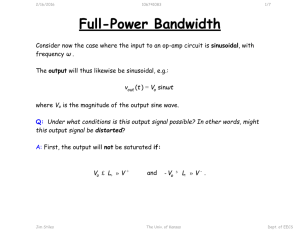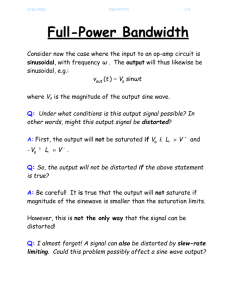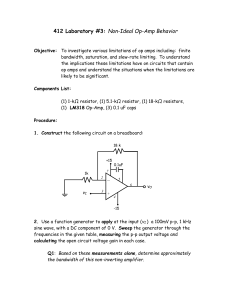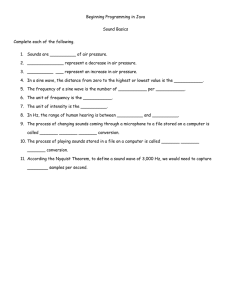Full-Power Bandwidth
advertisement
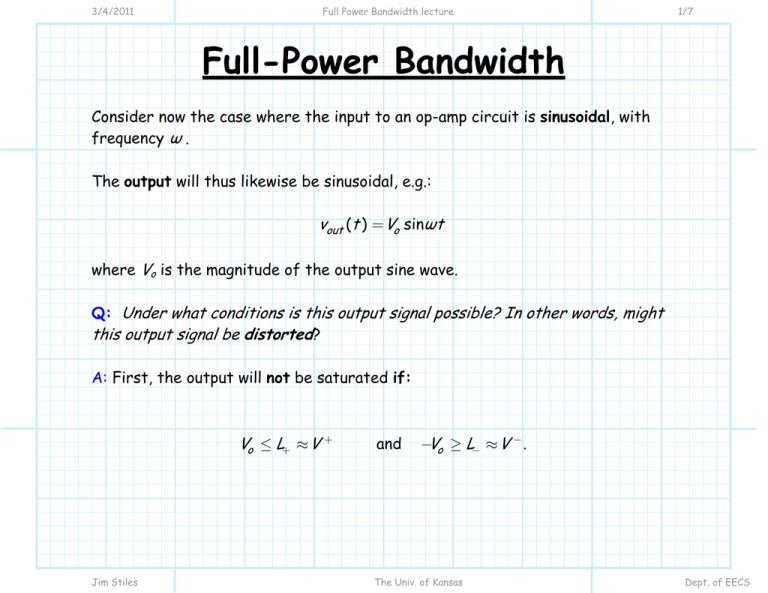
3/4/2011 Full Power Bandwidth lecture 1/7 Full-Power Bandwidth Consider now the case where the input to an op-amp circuit is sinusoidal, with frequency ω . The output will thus likewise be sinusoidal, e.g.: vout (t ) = Vo sinωt where Vo is the magnitude of the output sine wave. Q: Under what conditions is this output signal possible? In other words, might this output signal be distorted? A: First, the output will not be saturated if: Vo ≤ L+ ≈ V + Jim Stiles and −Vo ≥ L− ≈ V − . The Univ. of Kansas Dept. of EECS 3/4/2011 Full Power Bandwidth lecture 2/7 The time derivative Q: So, the output will not be distorted if the above statement is true? A: Be careful! It is true that the output will not saturate if magnitude of the sinewave is smaller than the saturation limits. However, this is not the only way that the signal can be distorted! Q: I almost forgot! A signal can also be distorted by slew-rate limiting. Could this problem possibly affect a sine wave output? A: Recall that the slew rate is a limit on the time derivative of the output signal. The time derivative of our sine wave output is: d vout (t ) = ωVo cosωt dt Jim Stiles The Univ. of Kansas Dept. of EECS 3/4/2011 Full Power Bandwidth lecture 3/7 The max and min Note that the time derivative is proportional to the signal frequency ω . Makes sense! As the output signal frequency increases, the output voltage changes more rapidly with time. Also note however, that this derivative is a likewise a function of time. The maximum value occurs when cos ωt = 1 , i.e,: d vout (t ) dt max = ω Vo while the minimum value occurs when cos ωt = −1 , i.e.,: d vout (t ) dt min = −ωVo Thus, we find that the output signal will not be distorted if these values are within the slew rate limits of the op-amp. Jim Stiles The Univ. of Kansas Dept. of EECS 3/4/2011 Full Power Bandwidth lecture 4/7 A simple way to determine you are slew rate limited In other words, to avoid distortion by slew rate limiting, we find: ω Vo ≤ S .R . and −ω Vo ≥ −S .R . Note that: 1) These two equations are equivalent! 2) The conditions that cause slew-rate distortion depend on both the magnitude Vo and the frequency ω of the output signal! Jim Stiles The Univ. of Kansas Dept. of EECS 3/4/2011 Full Power Bandwidth lecture 5/7 The frequency can only be so large Now, recall that there are limits on the magnitude alone, that is: Vo ≤ L+ ≈ V + to avoid saturation. Let’s assume that the output sine wave is as large as it can be without saturating, i.e., Vo = V + and thus: vout (t ) = V + sinωt We then find to avoid slew-rate limiting: ω V + < S .R . Rearranging, a limit on the maximum frequency for this sine wave output (one with maximum amplitude) is: S .R . ω < + ωM V Jim Stiles The Univ. of Kansas Dept. of EECS 3/4/2011 Full Power Bandwidth lecture 6/7 Full-Power bandwidth The value: ωM = SR V + is called the full-power bandwidth of the op-amp (given a DC supply V + ). It eauals the largest frequency a full-power (i.e., Vo = V + ) sine wave can obtain without being distorted by slew rate limiting! Thus, if the input signal to ω V + < S .R . an op-amp circuit is a sine wave, we might have to worry about slew rate limiting, if the signal frequency is greater than the full-power bandwidth (i.e., ω > ωM ). Jim Stiles The Univ. of Kansas Dept. of EECS 3/4/2011 Full Power Bandwidth lecture 7/7 I’ll find out from the exam if you read this page Please note these important facts about full-power bandwidth: 1) The analysis above was performed for a sine wave signal. It is explicitly accurate only for a sine wave signal. For some other signal, you must determine the time derivate, and then determine its maximum (or minimum) value! 2) Full-power bandwidth is completely different than the closed-loop amplifier bandwidth. For example, a signal with a frequency greater than the closed-loop amplifier bandwidth will not result in a distorted signal! 3) Distortion due to slew-rate limiting depends both on signal amplitude V + and signal frequency ω . Thus, as sine wave whose frequency is much greater than the full-power bandwidth (i.e., ω ωM ) may be undistorted if its amplitude V + is sufficiently small. Jim Stiles The Univ. of Kansas Dept. of EECS
